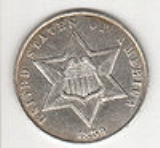
United States Mint coin sizes
Encyclopedia
The United States Mint
has minted over 20 different kinds of coin
s, of many different sizes. Often, it is difficult for people to get a grasp of what much of the historical coinage looked like, at least in relation to modern circulating coins. This chart shows all of the coin types, and their sizes, grouped by coins of similar size and by general composition.
Five distinct types of coin composition have been utilized over the past 200 years: two base coin alloy
s, silver
, gold
, and in recent years, platinum
. The base metal coins were generally alloys of copper (for 2 cent coins and lower), and copper/nickel
(for 3 and 5 cent coins). Copper/nickel composition is also used for all modern "silver" coins.
Notes on the tables:
The largest coin ever minted by the US Mint was a gold "Half Union" pattern in 1877, weighing 83.45 grams, and 51.1 mm in diameter. The largest coin actually issued by the mint was the Panama-Pacific Exposition $50 gold commemorative, at 83.572 grams and 44 mm. An octagonal version of the coin was slightly larger, measuring 45 mm at its widest point.
United States Mint
The United States Mint primarily produces circulating coinage for the United States to conduct its trade and commerce. The Mint was created by Congress with the Coinage Act of 1792, and placed within the Department of State...
has minted over 20 different kinds of coin
Coin
A coin is a piece of hard material that is standardized in weight, is produced in large quantities in order to facilitate trade, and primarily can be used as a legal tender token for commerce in the designated country, region, or territory....
s, of many different sizes. Often, it is difficult for people to get a grasp of what much of the historical coinage looked like, at least in relation to modern circulating coins. This chart shows all of the coin types, and their sizes, grouped by coins of similar size and by general composition.
Five distinct types of coin composition have been utilized over the past 200 years: two base coin alloy
Alloy
An alloy is a mixture or metallic solid solution composed of two or more elements. Complete solid solution alloys give single solid phase microstructure, while partial solutions give two or more phases that may or may not be homogeneous in distribution, depending on thermal history...
s, silver
Silver
Silver is a metallic chemical element with the chemical symbol Ag and atomic number 47. A soft, white, lustrous transition metal, it has the highest electrical conductivity of any element and the highest thermal conductivity of any metal...
, gold
Gold
Gold is a chemical element with the symbol Au and an atomic number of 79. Gold is a dense, soft, shiny, malleable and ductile metal. Pure gold has a bright yellow color and luster traditionally considered attractive, which it maintains without oxidizing in air or water. Chemically, gold is a...
, and in recent years, platinum
Platinum
Platinum is a chemical element with the chemical symbol Pt and an atomic number of 78. Its name is derived from the Spanish term platina del Pinto, which is literally translated into "little silver of the Pinto River." It is a dense, malleable, ductile, precious, gray-white transition metal...
. The base metal coins were generally alloys of copper (for 2 cent coins and lower), and copper/nickel
Nickel
Nickel is a chemical element with the chemical symbol Ni and atomic number 28. It is a silvery-white lustrous metal with a slight golden tinge. Nickel belongs to the transition metals and is hard and ductile...
(for 3 and 5 cent coins). Copper/nickel composition is also used for all modern "silver" coins.
| Copper | Copper Alloys | Silver | Gold | Platinum | ||
|---|---|---|---|---|---|---|
| Three Cent 14 mm 0.75 g 1851-1873 |
||||||
| Half Dime 15.5 mm 1.24 g 1794-1873 |
Dollar 15 mm 1.67 gr 1849-1889 |
$5 Bullion 16.5 mm 3.11 g 1986-present |
$10 Bullion 16.5 mm 3.11 g 1997-present |
|||
| Three Cent 17.9 mm 1.94 g 1865-1889 |
Dime 17.91 mm 2.268 g 1965-present |
Dime 17.9 mm 2.5 g 1796-1964 |
Quarter Eagle 18 mm 4.2 g 1796-1929 |
|||
| Small Cent 19.05 mm 2.5 g 1857-present |
Three Dollar 20.5 mm 5.01 g 1853-1876 |
|||||
| Nickel 21.21 mm 5 g 1866-present |
Twenty Cent 22 mm 5 g 1875-1878 |
Half Eagle 21.6 mm 8.36 g 1795-1929 |
$10 Bullion 22 mm 7.78 g 1986-present |
$25 Bullion 22 mm 7.78 g 1997-present |
||
| Half Cent 23.5 mm 6.74 g 1795-1857 |
Two Cent 23 mm 6.22 g 1864-1873 |
Quarter 24.26 mm 5.67 g 1965-present |
Quarter 24.3 mm 6.25 g 1796-1965 |
|||
| Dollar 26.5 mm 8.1 g 1979-present |
Eagle 27 mm 17.5 g 1795-1933 |
$25 Bullion 27 mm 17.5 g 1986-present |
$50 Bullion 27 mm 15.6 g 1997-present |
|||
| Large Cent 29 mm 10.89 g 1793-1857 |
Half Dollar 30.61 mm 11.34 g 1971-present |
Half Dollar 30.6 mm 12.5 g 1796-1970 |
||||
| $50 Bullion 32.7 mm 31.1 g 1986-present |
$100 Bullion 32.7 mm 31.1 g 1997-present |
|||||
| Double Eagle 34 mm 35 g 1850-1933 |
||||||
| Dollar 38.1 mm 22.68 g 1971-1978 |
Dollar 38.1 mm 26.73 g 1794-1970 |
|||||
| $1 Bullion 40.6 mm 31.1 g 1986-present |
||||||
| Copper | Copper Alloy | Silver | Gold | Platinum | ||
|---|---|---|---|---|---|---|
 |
||||||
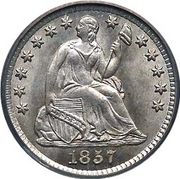 |
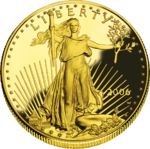 |
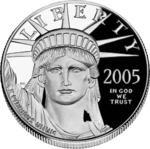 |
||||
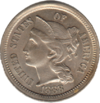 |
 |
 |
||||
 |
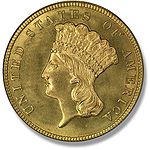 |
|||||
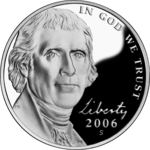 |
 |
 |
||||
 |
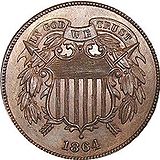 |
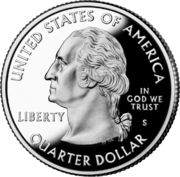 |
||||
 |
 |
 |
||||
 |
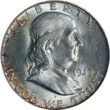 |
|||||
 |
 |
|||||
 |
 |
|||||
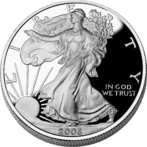 |
||||||
Notes on the tables:
- Images are close to actual size on a 92-dpiDPIDPI may stand for* Dots per inch, a measure of printing resolution* Dhaka Polytechnic Institute, an educational institution of Bangladesh* Death Pact International, one of the first open source musical concept projects...
monitor. - Silver Half Dollars and Dollars, and Gold Half Eagles and Eagles are still regularly minted as commemorative coins. Dimes, quarters, and half dollars are also struck in 90% silver for certain annual collector's sets.
- The silver-colored Susan B. Anthony dollarSusan B. Anthony dollarThe Susan B. Anthony dollar is a United States coin minted from 1979 to 1981, and again in 1999. It depicts women's suffrage campaigner Susan B. Anthony on a dollar coin. It was the first circulating U.S. coin with the portrait of an actual woman rather than an allegorical female figure such as...
was replaced with gold-colored Sacagawea Dollar in 2000; though the composition changed, the coin's size and weight remain the same. - Some variances in coin size and weight occurred over time, especially as the value of silver varied. In particular, many silver coins changed in the 1870s. The figures cited in the tables are representative of the series, and are generally the latest, or most common, figures for a given coin type.
The largest coin ever minted by the US Mint was a gold "Half Union" pattern in 1877, weighing 83.45 grams, and 51.1 mm in diameter. The largest coin actually issued by the mint was the Panama-Pacific Exposition $50 gold commemorative, at 83.572 grams and 44 mm. An octagonal version of the coin was slightly larger, measuring 45 mm at its widest point.

